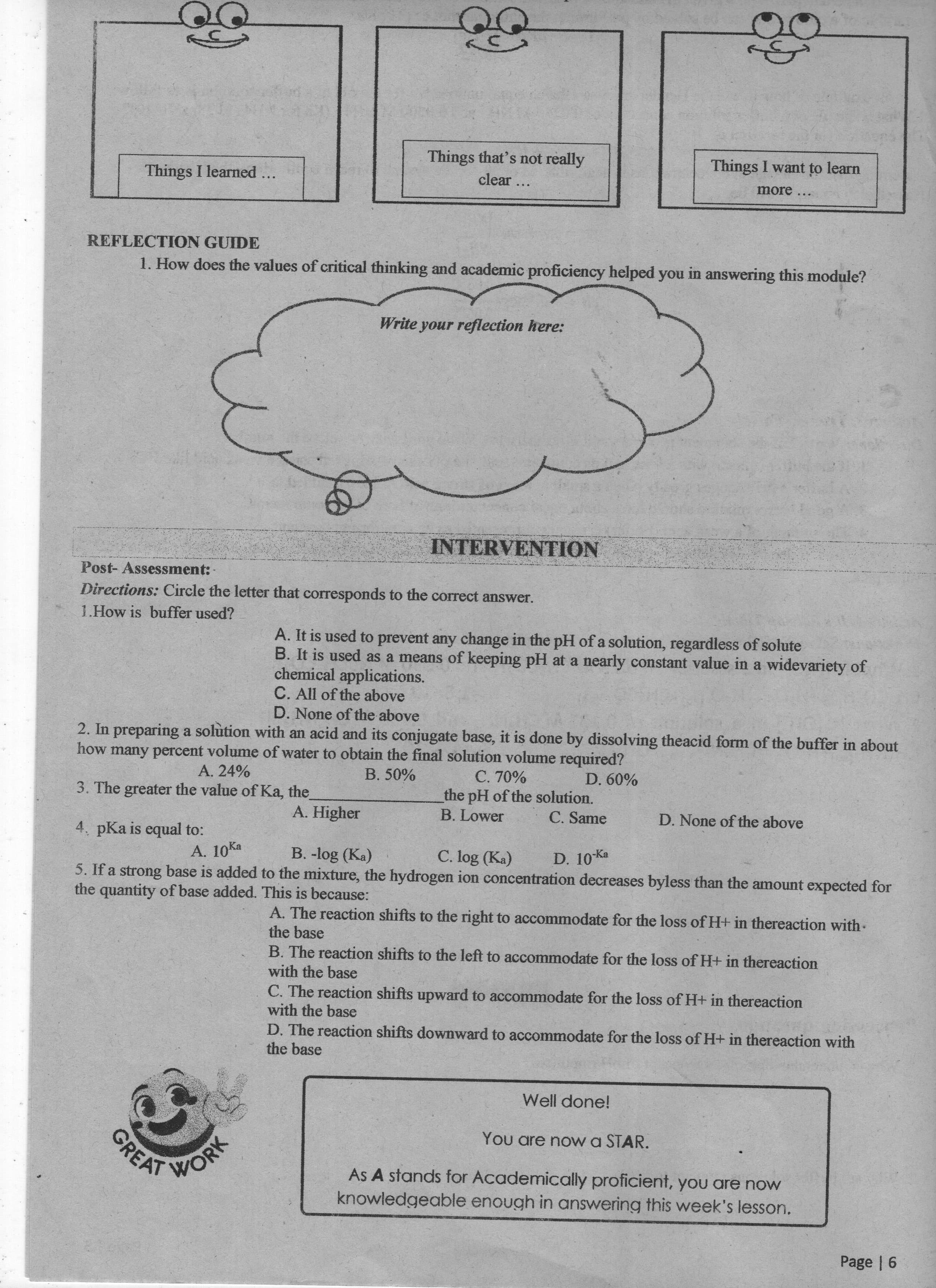Chemistry
10th Edition
ISBN:9781305957404
Author:Steven S. Zumdahl, Susan A. Zumdahl, Donald J. DeCoste
Publisher:Steven S. Zumdahl, Susan A. Zumdahl, Donald J. DeCoste
Chapter1: Chemical Foundations
Section: Chapter Questions
Problem 1RQ: Define and explain the differences between the following terms. a. law and theory b. theory and...
Related questions
Question
100%
MULTIPLE CHOICE ONLY 1-5

Transcribed Image Text:Things that's not really
Things I want to learn
Things I learned ...
clear ...
more
REFLECTION GUIDE
1. How does the values of critical thinking and academic proficiency helped you in answering this module?
Write your reflection here:
INTERVENTION
Post- Assessment:
Directions: Circle the letter that corresponds to the correct answer.
1.How is buffer used?
A. It is used to prevent any change in the pH of a solution, regardless of solute
B. It is used as a means of keeping pH at a nearly constant value in a widevariety of
chemical applications.
C. All of the above
D. None of the above
2. In preparing a solution with an acid and its conjugate base, it is done by dissolving theacid form of the buffer in about
how many percent volume of water to obtain the final solution volume required?
C. 70%
the pH of the solution.
B. Lower
A. 24%
B. 50%
3. The greater the value of Ka, the
A. Higher
C. Same
D. None of the above
4. pKa is equal to:
A. 10Ka
B. -log (Ka)
C. log (Ka)
D. 10 Ka
5. If a strong base is added to the mixture, the hydrogen ion concentration decreases byless than the amount expected for
the quantity of base added. This is because:
A. The reaction shifts to the right to accommodate for the loss of H+ in thereaction with-
the base
B. The reaction shifts to the left to accommodate for the loss of H+ in thereaction
with the base
C. The reaction shifts upward to accommodate for the loss of H+ in thereaction
with the base
D. The reaction shifts downward to accommodate for the loss of H+ in thereaction with
the base
Well done!
WORK
GREAT
You are now a STAR.
As A stands for Academically proficient, you are now
knowledgeable enough in answering this week's lesson.
Page | 6
Expert Solution
This question has been solved!
Explore an expertly crafted, step-by-step solution for a thorough understanding of key concepts.
Step by step
Solved in 6 steps

Knowledge Booster
Learn more about
Need a deep-dive on the concept behind this application? Look no further. Learn more about this topic, chemistry and related others by exploring similar questions and additional content below.Recommended textbooks for you

Chemistry
Chemistry
ISBN:
9781305957404
Author:
Steven S. Zumdahl, Susan A. Zumdahl, Donald J. DeCoste
Publisher:
Cengage Learning

Chemistry
Chemistry
ISBN:
9781259911156
Author:
Raymond Chang Dr., Jason Overby Professor
Publisher:
McGraw-Hill Education

Principles of Instrumental Analysis
Chemistry
ISBN:
9781305577213
Author:
Douglas A. Skoog, F. James Holler, Stanley R. Crouch
Publisher:
Cengage Learning

Chemistry
Chemistry
ISBN:
9781305957404
Author:
Steven S. Zumdahl, Susan A. Zumdahl, Donald J. DeCoste
Publisher:
Cengage Learning

Chemistry
Chemistry
ISBN:
9781259911156
Author:
Raymond Chang Dr., Jason Overby Professor
Publisher:
McGraw-Hill Education

Principles of Instrumental Analysis
Chemistry
ISBN:
9781305577213
Author:
Douglas A. Skoog, F. James Holler, Stanley R. Crouch
Publisher:
Cengage Learning

Organic Chemistry
Chemistry
ISBN:
9780078021558
Author:
Janice Gorzynski Smith Dr.
Publisher:
McGraw-Hill Education

Chemistry: Principles and Reactions
Chemistry
ISBN:
9781305079373
Author:
William L. Masterton, Cecile N. Hurley
Publisher:
Cengage Learning

Elementary Principles of Chemical Processes, Bind…
Chemistry
ISBN:
9781118431221
Author:
Richard M. Felder, Ronald W. Rousseau, Lisa G. Bullard
Publisher:
WILEY